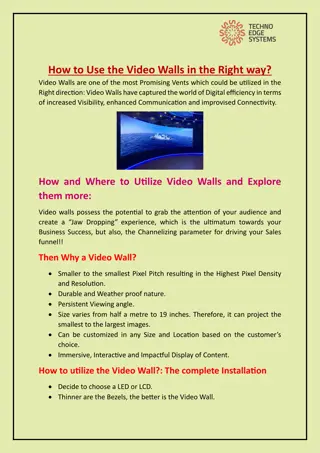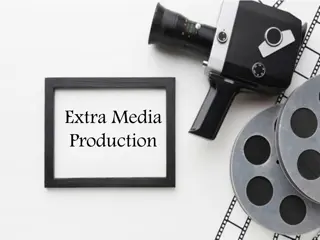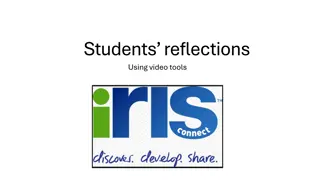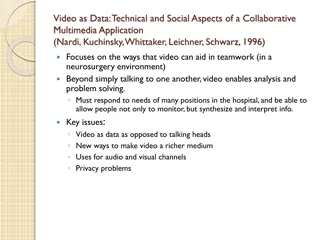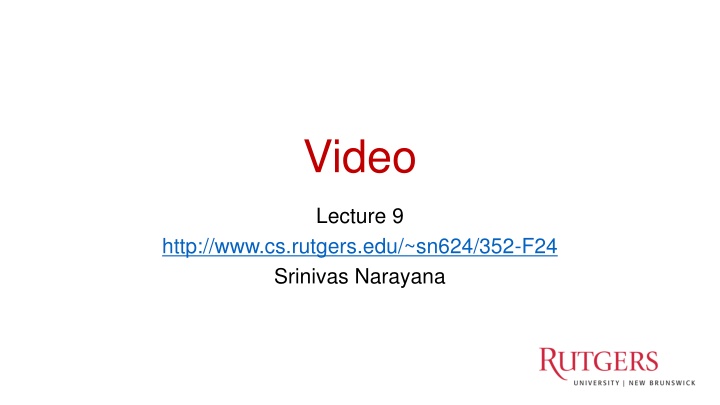
Digital Representation of Audio and Video
Explore the process of converting analog signals to digital representation, sampling, quantization, and compression in audio and video formats. Learn about the bandwidth requirements, quantized values, quality considerations, and encoding methods for efficient data transmission.
Download Presentation

Please find below an Image/Link to download the presentation.
The content on the website is provided AS IS for your information and personal use only. It may not be sold, licensed, or shared on other websites without obtaining consent from the author. If you encounter any issues during the download, it is possible that the publisher has removed the file from their server.
You are allowed to download the files provided on this website for personal or commercial use, subject to the condition that they are used lawfully. All files are the property of their respective owners.
The content on the website is provided AS IS for your information and personal use only. It may not be sold, licensed, or shared on other websites without obtaining consent from the author.
E N D
Presentation Transcript
Video Lecture 9 http://www.cs.rutgers.edu/~sn624/352-F24 Srinivas Narayana 1
Digital representation of audio and video
Digital representation of audio Must convert analog signal to digital representation Sample How many times (twice the max frequency in the signal) Quantize How many levels or bits to represent each sample More levels more accurate representation of signal More levels more bits to store & need more bandwidth to transmit Compress Compact representation of quantized values 3
Audio representation analog audio signal sampled at constant rate telephone: 8,000 samples/sec CD music: 44,100 samples/sec each sample quantized, i.e., rounded e.g., 28=256 possible quantized values each quantized value represented by bits, e.g., 8 bits for 256 values quantization quantized value of analog value error audio signal amplitude analog signal time sampling rate (N sample/sec) 4
Audio representation example: 8,000 samples/sec, 256 quantized values Bandwidth needed: 64,000 bps quantization quantized value of analog value error audio signal amplitude analog signal receiver converts bits back to analog signal: some quality reduction time Example rates CD: 1.411 Mbps MP3: 96, 128, 160 Kbps Internet telephony: 5.3 Kbps and up sampling rate (N sample/sec) 5
Video representation Video: sequence of images displayed at constant rate e.g., 30 images/sec Appear continuous due to the stroboscopic effect frame i frame i+1 6
Video representation spatial coding example: instead of sending N values of same color (all purple), send only two values: color value (purple) and number of repeated values (N) Digital image: array of pixels each pixel represented by bits Encode luminance and color Number of pixels: resolution Coding: use redundancy within and between images to decrease # bits used to encode image spatial (within image) temporal (from one image to next) Encoding/decoding algorithm often called a codec ... ... frame i temporal coding example: instead of sending complete frame at i+1, send only differences from frame i (motion vectors) frame i+1 7
Video codecs: terminology Video bit rate: effective number of bits per second of the video after encoding It depends on many factors Resolution of each image: more pixels = more bits Detail per pixel: more luminance & color detail = more bits Amount of movement in the video. More movement = more bits Quality of overall compression in the codec Video bit rate is typically correlated with quality of perception Higher bit rate == better to perceive
Bit-rates: terminology Bit-rate of a video changes over the duration of the video CBR: (constant bit rate): fixed bit-rate video VBR: (variable bit rate): different parts of the video have different bit rates, e.g., changes in color, motion, etc. For VBR, we talk about average bit-rate over video s duration Examples of average video bit-rates MPEG 1 (CD-ROM) 1.5 Mbps. MPEG2 (DVD) 3-6 Mbps MPEG4 (often used in Internet, < 1 Mbps) In general, one Internet video stream takes up a few Mbit/s (more for HD) https://blog.video.ibm.com/streaming-video-tips/what-is-video-encoding-codecs-compression-techniques/
Networking multimedia: 3 types On-demand streamed video/audio Can begin playout before downloading the entire file Ful video/audio stored at the server: able to transmit faster than audio/video will be rendered (with storing/buffering at client) e.g., Spotify, YouTube, Netflix Conversationalvoice or video over IP interactive human-to-human communication limits delay tolerance e.g., Zoom Live streamed audio, video e.g, sporting event on sky sports Can delay a little, but must be close to the live edge of content
Streaming (stored) video Media is prerecorded at different qualities Available in storage at the server Client downloads an initial portion and starts viewing The rest is downloaded as time progresses No need for user to wait for entire content to be downloaded (streaming) Can change the quality of the content and where it s fetched mid-stream
Streaming stored video Constant bit rate video Client e.g., your phone 2. video sent 1. video recorded (e.g., 30 frames/sec) 3. video received, played out at client (30 frames/sec) network delay (fixed in this example) time streaming: at this time, client playing out early part of video, while server still sending later part of video Server e.g. Netflix 13
Streaming stored video: challenges Continuous playout constraint: once video playout begins at client, time gap between frames must match the original time gap in the video (why?) But network delays are variable! Clients have a client-side buffer of downloaded video to absorb variation in network delay, available bandwidth The video buffer also helps with user interactions: pause, fast- forward, rewind, jump through video 14
Introduce a delay for smooth playout constant bit rate video transmission client video reception constant bit rate video playout at client variable network delay buffered video time client playout delay Client-side buffering with playout delay: compensate for variations in the network delay 15
But not too small a delay constant bit rate video transmission client video reception constant bit rate video playout at client variable network delay buffered video time client playout delay Playout delay that s too small can cause stalls There s nothing in the buffer to show to the user 16



